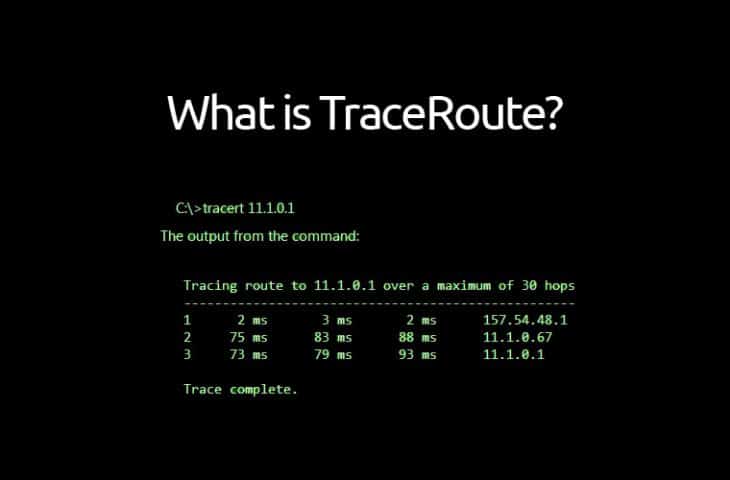What is 30 hops traceroute?
Summary of the Article: What is 30 hops traceroute?
A datagram starts with 30 hops, if it doesn’t reach its destination by 30 hops, the sending node gets notified that the node or Host is Unreachable. Tracert – Windows/NT built-in traceroute utility which is run in the dos window.
Understanding the traceroute. In the results you will see the comment, “over a maximum of 30 hops or 64.” All this means is that the diameter of the Internet is roughly 30 or 64 hops. Therefore, many trace routes will only go that far out in trying to reach a destination.
Each entry, or hop, is a location that the packet passes through to reach its final destination. If the trace times out on a certain hop it can mean there is a problem at that location, or that the route is incorrect, preventing the packet from reaching the destination.
A simple example of this would be to run a traceroute from your computer to Catchpoint’s servers. The specific results will be different for each person. However, in most cases, the results will show you somewhere around 15-20 “hops” that data takes to get from your computer to Catchpoint’s servers and back.
The maximum number of hops is 30 by default and can be specified using the /h parameter. The path is determined by examining the ICMP time Exceeded messages returned by intermediate routers and the echo Reply message returned by the destination.
By default, the upper limit is 30 hops, but a different value can be specified when the command is run. When finished, traceroute prints all the hops in the path, along with the amount of time it took to each hop and back (this is known as the Round Trip Time).
Each time that a packet of data moves from one router (or device) to another — say from the router of your home network to the one just outside your county line — that is considered one HOP. The HOP count is the total number of HOPs that a packet of data travels.
HOP counts refer to the number of devices, usually routers, that a piece of data travels through. Each time that a packet of data moves from one router (or device) to another — say from the router of your home network to the one just outside your county line — that is considered one HOP.
The maximum hop count for RIP routers is 15. Networks with a hop count of 16 or more are considered unreachable.
The HOP count is the total number of HOPs that a packet of data travels. Let’s say you’re on your home laptop and you want to look at the website of the Louvre in Paris. To get all the way from your home office to www.Louvre.fr, you might travel through eighteen routers (or eighteen HOPS) to get to that location.
HOP counts refer to the number of devices, usually routers, that a piece of data travels through. Each time that a packet of data moves from one router (or device) to another — say from the router of your home network to the one just outside your county line — that is considered one HOP.
HOP counts refer to the number of devices, usually routers, that a piece of data travels through. Each time that a packet of data moves from one router (or device) to another — say from the router of your home network to the one just outside your county line — that is considered one HOP.
HOP counts refer to the number of devices, usually routers, that a piece of data travels through. Each time that a packet of data moves from one router (or device) to another — say from the router of your home network to the one just outside your county line — that is considered one HOP.

What does 30 hops mean
A datagram starts with 30 hops, if it doesn't reach its destination by 30 hops, the sending node gets notified that the node or Host is Unreachable. Tracert – Windows/NT built-in traceroute utility which is run in the dos window.
Cached
Why does traceroute make at max 30 hops
Understanding the traceroute
In the results you will see the comment, "over a maximum of 30 hops or 64." All this means is that the diameter of the Internet is roughly 30 or 64 hops. Therefore, many trace routes will only go that far out in trying to reach a destination.
What is hops on traceroute
Each entry, or hop, is a location that the packet passes through to reach its final destination. If the trace times out on a certain hop it can mean there is a problem at that location, or that the route is incorrect, preventing the packet from reaching the destination.
How many traceroute hops is normal
A simple example of this would be to run a traceroute from your computer to Catchpoint's servers. The specific results will be different for each person. However, in most cases, the results will show you somewhere around 15-20 “hops” that data takes to get from your computer to Catchpoint's servers and back.
Cached
What is maximum of 30 hops
The maximum number of hops is 30 by default and can be specified using the /h parameter. The path is determined by examining the ICMP time Exceeded messages returned by intermediate routers and the echo Reply message returned by the destination.
How many hops is too many traceroute
By default, the upper limit is 30 hops, but a different value can be specified when the command is run. When finished, traceroute prints all the hops in the path, along with the amount of time it took to each hop and back (this is known as the Round Trip Time).
What does 1 hop mean
Each time that a packet of data moves from one router (or device) to another — say from the router of your home network to the one just outside your county line — that is considered one HOP. The HOP count is the total number of HOPs that a packet of data travels.
What does number of hops mean
HOP counts refer to the number of devices, usually routers, that a piece of data travels through. Each time that a packet of data moves from one router (or device) to another — say from the router of your home network to the one just outside your county line — that is considered one HOP.
What is the maximum hop count for IP rip
The maximum hop count for RIP routers is 15. Networks with a hop count of 16 or more are considered unreachable.
What is an example of a hop count
The HOP count is the total number of HOPs that a packet of data travels. Let's say you're on your home laptop and you want to look at the website of the Louvre in Paris. To get all the way from your home office to www.Louvre.fr, you might travel through eighteen routers (or eighteen HOPS) to get to that location.
How far is 1 hop
HOP counts refer to the number of devices, usually routers, that a piece of data travels through. Each time that a packet of data moves from one router (or device) to another — say from the router of your home network to the one just outside your county line — that is considered one HOP.
Why RIP hop count is 15
Because in computing, binary form is used for storing numbers. In this case the maximum binary number in four positions would be 15 (1111). So they reserved four digits to count the hops. It seemed to be enough at the time they developed RIP.
How do you calculate hop
From a formulaic or mathematical point of view, hop utilization breaks down accordingly: %U(utilization) = (isoalpha acids present¸ alpha acid used) x 100.
What is bad hop count
The bad hop count counter is increased when the router receives a packet with a TTL of zero. This might be normal if you have multicast traffic sent with low TTLs. Since you don't have multicast on this router, you can do a "debug ip error" on this router to determine what traffic is being discarded.
What is a 3 hop
The three-hop test is a test of explosive leg power, in which you have to perform three consecutive horizontal jumps, taking off both legs at once for each jump.
How do you calculate hop count
However, the easiest way to get a hop count is by using the tracert command that comes with Command Prompt in Windows. Among other things, you'll be shown the hops as they occur, with the last hop number being the total hop count.
What is hop count 16
The term hop count is also referred to as the metric. In RIP, a hop count of 16 means infinity, or that the destination cannot be reached. This limits the longest path in the network that can be managed by RIP to 15 gateways.



0 Comments